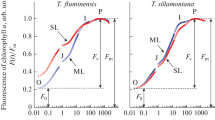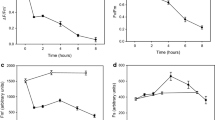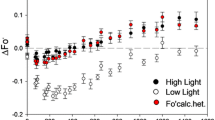Summary
The possible mechanism which leads to inactivation phenomena at high intensities of blue light during the color-sensitive phase in the time course of the Hill reaction was investigated in more detail. The following results were obtained: a) The inhibition of the Hill reaction is also observed during but not prior to the color-sensitive state if the supernatant of a blue-illuminated chloroplast suspension is used as a medium for a fresh assay in red light. b) Addition of linolenic acid, which leads to a stimulation of electron transport in intact chloroplasts, intensifies the inhibition at the blue-light-sensitive stage. c) The content of malondialdehyde, an indicator for free-radical-type breakdown of unsaturated fatty acids, increases selectively after blue-light exposure during the color-sensitive phase of the Hill reaction. This result was obtained with both the thiobarbituric-acid test and fluorescence measurements of Schiff-base type conjugates. d) The gas chromatograms of total chloroplast lipids show a different spectrum for plastids exposed to blue light when compared to a non-illuminated control sample. The changes imply alterations in the composition of long-chain fatty acids. These results warrant the conclusion that the blue-light inhibition is closely linked to fatty-acid breakdown which is sensitized by light absorbed by pigments detached from the photosynthetic centers during the process of chloroplast aging in vitro.
Similar content being viewed by others
References
Borst, P. J., Loos, A., Christ, E. J., Slater, E. D.: Uncoupling activity of long chain fatty acids. Biochim. biophys. Acta (Amst.) 62, 509–518 (1962).
Butler, R. D., Simon, E. D.: Ultrastructural aspects of senescence in plants. Adv. Geront. Res. 3, 73–129 (1971).
Chio, K. S., Reiss, U., Fletcher, B., Tappel, A. L.: Peroxidation of subcellular organelles: formation of lipofuscin-like fluorescent pigments. Science 166, 1535 (1969).
Dahle, L. K., Hill, E. G., Holman, R. T.: The thiobarbituric acid reaction and the autooxidation of polyunsaturated fatty acid methylesters. Arch. Biochem. 98, 253–261 (1962).
Goodman, D. S.: The interaction of human serum albumin with long chain fatty acids. J. Amer. chem. Soc. 80, 3892–3898 (1947).
Harnischfeger, G.: Changes in appearance, volume and activity during the early stages of disintegration in isolated chloroplasts. Planta (Berl.) 92, 164–177 (1970).
Harnischfeger, G., Gaffron, H.: Transient color sensitivity of the Hill reaction during the disintegration of chloroplasts. Planta (Berl.) 89, 383–388 (1969).
Harnischfeger, G., Gaffron, H.: Transient light effects in the Hill reaction of disintegrating chloroplasts in vitro. Planta (Berl.) 93, 89–105 (1970).
Heath, R. L., Packer, L.: Photoperoxidation in isolated chloroplasts. I. Kinetics and stochiometry of fatty acid peroxidation. Arch. Biochem. 125, 189–198 (1968).
Heath, R.L., Packer, L.: Photoperoxidation in isolated chloroplasts. II. Role of energy transfer. Arch. Biochem. 125, 850–857 (1968).
Packer, L., Deamer, D.W., Heath, R. L.: Regulation and deterioration of structure in membranes. Adv. Geront. Res. 2, 77–120 (1967).
Pohl, P., Glasl, H., Wagner, H.: Zur Analytik pflanzlicher Glyko- und Phospholipide und ihrer Fettsäuren. I. Eine neue dünnschichtchromatographische Methode zur Trennung pflanzlicher Lipoide und quantitativen Bestimmung ihrer Fettsäurezusammensetzung. J. Chromatography 49, 488–492 (1972).
Satoh, K.: Mechanism of photoinactivation in photosynthetic systems. I. The dark reaction in photoinactivation. Plant Cell Physiol. 11, 15–28 (1970a).
Satoh, K.: Mechanisms of photoinactivation in photosynthetic systems. II. The occurrence and properties of two different types of photoinactivation. Plant Cell Physiol. 11, 29–38 (1970b).
Siegenthaler, P. A.: Chloroplast aging in vitro and relationships to fatty acids and polyphenol-oxidase activity. Experientia (Basel) 26, 1308–1310 (1970).
Tarladgis, B. G., Pearson, A. M., Dugan, L. R., Jr.: Chemistry of the 2-thiobarbituric acid test for determination of oxidative rancidity in foods. II. Formation of the TBA-malonaldehyde complex without acid heat treatment. J. Sci. Food Agric. 15, 602–607 (1964).
Wintermans, J. F. G. M., Helmsing, P. J., Polman, B. J. J., van Gisbergen, J., Colard, J.: Galactolipid transformations and photochemical activities of spinach chloroplasts. Biochim. biophys. Acta (Amst.) 189, 95–105 (1969).
Author information
Authors and Affiliations
Additional information
Supported in part by grant NGR10-004-018 of the National Aeronautics and Space Administration (NASA) to Dr. Hans Gaffron and in part by the Bundesministerium für Bildung and Wissenschaft of the Federal Republic of Germany.
Rights and permissions
About this article
Cite this article
Harnischfeger, G. Photosensitized inhibitor formation in isolated, aging chloroplasts. Planta 104, 316–328 (1972). https://doi.org/10.1007/BF00386315
Received:
Issue Date:
DOI: https://doi.org/10.1007/BF00386315




